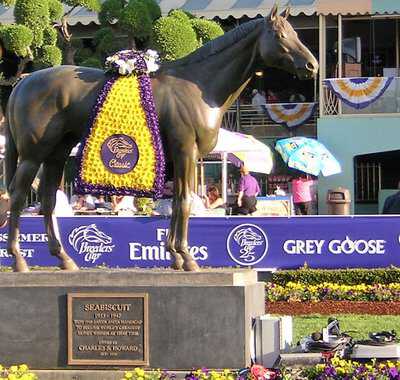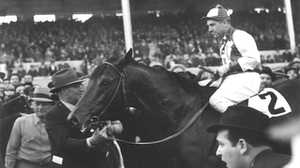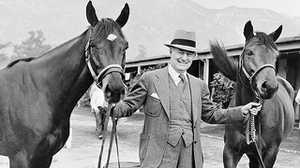Seabiscuit's Obituary
America’s favorite underdog died young, succumbing to a heart attack at age 14.

Read Pulitzer Prize-winning sportswriter Walter Wellesley “Red” Smith’s remembrance of Seabiscuit, followed by a wire service article reporting on the great horse’s demise.
Views of Sport
By Red Smith
New York Herald Tribune, Tuesday, May 20, 1947
A Horse You Had to Like
If this bureau had a prayer for use around horse parks, it would go something like this: Lead us not among bleeding-hearts to whom horses are cute or sweet or adorable, and deliver us from horse lovers. Amen.
In this case, issue is not taken on the rhetorical grounds adopted by James Thurber when he observed that to him the expression “dog lover” meant one dog that was in love with another dog. Rather, the idea here is to merely get on record with the opinion that horses are animals which a guy can like and admire and have fun betting on or just watching. This is no great knock on love, which is for blondes.
With that established, let’s talk about the death of Seabiscuit the other night. It isn’t mawkish to say there was a racehorse, a horse that gave race fans as much pleasure as any that ever lived, and one that will be remembered as long and as warmly. If someone asked you to list horses which had, apart from speed or endurance, some quality that fixed the imagination and captured the regard of more people than ever saw them run, you’ve had to mention Man o'War and Equipoise and Exterminator, and Whirlaway, and Seabiscuit. And the honest son of Hard Tack wouldn’t be last.
It wasn’t primarily his rags-to-riches history which won Seabiscuit his following, although reaching success from humble beginnings never dims a public figure’s popularity. It wasn’t the fact that he won more money than any other horse up to his time, although that hurt neither his reputation nor his owner. He wasn’t a particularly handsome horse, nor especially big or graceful, and he was never altogether sound. Up till now, his gets have not made him famous as his sire.
The quality he had was expressed one day by a man in the press box who said, “Look at his record. He’s the Canzoneri of horses.”
From Agawam to Agua Caliente
Look at his record and you see what the man meant. Just as Tony Canzoneri barnstormed through the fight clubs of the land taking on every one they tossed at his head, so Seabiscuit made the rounds of most of the mile tracks between the oceans, and left track records at more than a few. Hialeah Park this record reads, Bowie, Havre de Grace, Jamaica, Rockingham, Narragansett, Suffolk, Saratoga, Aqueduct, Agawam, Empire City, Pimlico, Belmont, Detroit, River Downs, Bay Meadows, Santa Anita, Tanforan, Laurel, Agua Caliente, Arlington, Del Mar, Hollywood.
He didn’t always win, of course. Indeed, he was whipped seventeen times hand running in allowance purses and maiden races and claimers before he won one, and that one was worth $750. Those were the days when he went unclaimed for $2,500.
It has often been written how his first owner, Ogden Phipps [sic], tossed him away from $8,500 in a private sale to Charles S. Howard. Actually, Phipps did all right with him. Seabiscuit ran forty-seven times and won nine races for his breeder: His winnings and sale price brought Phipps $26,965. No one could have guessed he would earn $419,265 racing for Howard.
In these days when a Shetland pony won’t break out of a walk for less than $50,000, earnings are an incomplete measure of a horse’s class. Seabiscuit’s record of $437,730 has been surpassed by several horses. But he had to work for most of his. He often came out of a race with $25 or $50 in third or fourth money, and he had to make three runs at the Santa Anita Handicap, losing twice by a nose, before he grabbed his biggest prize of $86,650.
The Guys Around Him
With the news story of his death was a photograph of Seabiscuit with Red Pollard, his regular jockey. It brought to mind several names that were associated with the horse. There was his owner, who was known as “Lucky Charley” Howard when his stable, led by Seabiscuit was polishing off stakes like mad, making him first among money-winning owners. They haven’t started running benefits for Howard yet — he was nineteenth among owners with purses of $182,885 last year — but you don’t see those red and white silks out front as often as you did, and they don’t call him “Lucky Charley” any more.
There was Pollard, who certainly wasn’t ever called lucky. The little redhead rode to fame on Seabiscuit but he missed the ones he wanted most. He’d been second, beaten by a nose by Rosemont, in the Santa Anita Handicap of 1937 and he was getting ready for a second shot the following year when he got busted up in a spill. Had to sit back and look on while his horse lost the same race by the same margin, this time to Stagehand.
He was just about recovered from the injury when he came East to ride Seabiscuit in New England. A gypsy horseman, a friend, asked him to work a two-year-old for him. The colt bolted and smashed Pollard’s left leg. He was still laid up when Seabiscuit ran the most memorable race of all, the match with War Admiral.
Seabiscuit broke down in his next start, and Pollard went to the farm with him, put in a year helping to bring him around. They came back together in 1940, and together they finally won the $100,000 handicap. One hasn’t heard much of Red since, although he was still running a fair share of winners last year.
Then there’s Tom Smith, who trained Seabiscuit. He’s changed jobs and things haven’t been entirely smooth for him. Just got back this year from that suspension in that ephedrine case.
The Race Georgie Swiped
And then there was George Woolf, who rode Seabiscuit in the match with War Admiral, the best horse race these eyes have ever seen. That was the race where Sam Riddle, War Admiral’s owner, dictated virtually all the conditions, including a walk-up start because his horse didn’t like gates.
Ed Christmas was talking about Woolf recently, recalling how he used an old trick of quarter-horse racing to steal the start from Charley Kurtsinger, who didn’t have his experience of racing out on the Western plains. As they walked up to the line, Georgie kept Seabiscuit’s head turned in toward War Admiral, determined that if he didn’t get away alone, he’d leave no room for War Admiral to dart past him. If ever a rider swiped a race, Woolf swiped that one at the start, leaping away ahead of a horse that was habitually first out of the gate.
Georgie Woolf? He’s dead too.
Seabiscuit Dies of Heart Attack At C. S. Howard Ranch on Coast
New York Times, May 19, 1947
UKIAH, Calif., May 18 — Seabiscuit, one-time leading winner of the American turf, died of a heart attack last midnight, owner Charles S. Howard announced today.
Howard said that the famed racer, who earned a grand total of $437,730 between 1935 and 1940, when he was retired to stud at Howard’s Ridgewood Farms near here, had been normal at 6 P.M. last night.
Sergeant Joy, groom who slept in the stable where the 14-year-old horse was quartered, said he was awakened about midnight by sounds of stirring in Seabiscuit’s box stall. He found the horse struggling and immediately called Dr. John W. Britton, the farm’s veterinarian. Seabiscuit died ten minutes after the doctor’s arrival.
He was retired after winning the $100,000 Santa Anita Handicap of 1940 and was believed to have sired at least 100 horses since that time.
One of Seabiscuit’s greatest triumphs was his defeat of War Admiral in a special match race at Pimlico in 1938.
Howard purchased the horse as a 3-year-old for $8,000 and he appeared in eighty-nine races while wearing the Howard colors. He finished first thirty-three times, placed fifteen and ran third thirteen.
He will be buried in front of the ranch-house at Ridgewood.
The “Biscuit” first raced for the Wheatley Stable in the East, owned jointly by the late former Secretary of the Treasury Ogden Mills and his sister. In forty-seven races for the Wheatley owners, he won only nine starts. He was an outcast — not worth the price of his hay in a first-class barn.
In 1936, Howard was visiting the East and saw Seabiscuit for the first time. His record was unimpressive and he had suspicious knees.
The horse that was destined to win nearly half a million dollars was purchased for a mere $8,000. He was placed in the hands of Silent Tom Smith, one of the outstanding trainers of the nation, and from that time on his star was ascending.







